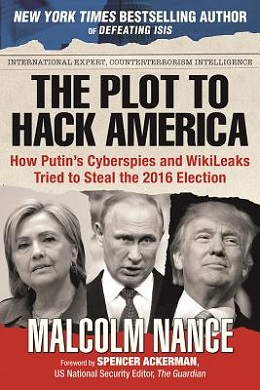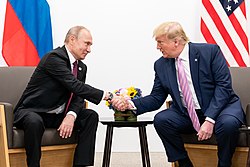Cyberwarfare by Russia includes denial of service attacks, hacker attacks, dissemination of disinformation and propaganda, participation of state-sponsored teams in political blogs, internet surveillance using SORM technology, persecution of cyber-dissidents and other active measures. According to investigative journalist Andrei Soldatov, some of these activities were coordinated by the Russian signals intelligence, which was part of the FSB and formerly a part of the 16th KGB department. An analysis by the Defense Intelligence Agency in 2017 outlines Russia's view of "Information Countermeasures" or IPb as "strategically decisive and critically important to control its domestic populace and influence adversary states", dividing 'Information Countermeasures' into two categories of "Informational-Technical" and "Informational-Psychological" groups. The former encompasses network operations relating to defense, attack, and exploitation and the latter to "attempts to change people's behavior or beliefs in favor of Russian governmental objectives."
Cozy Bear, classified by the United States federal government as advanced persistent threat APT29, is a Russian hacker group believed to be associated with one or more intelligence agencies of Russia. The Dutch General Intelligence and Security Service (AIVD) deduced from security camera footage that it is led by the Russian Foreign Intelligence Service (SVR), a view shared by the United States. Cybersecurity firm CrowdStrike also previously suggested that it may be associated with either the Russian Federal Security Service (FSB) or SVR. The group has been given various nicknames by other cybersecurity firms, including CozyCar, CozyDuke, Dark Halo, The Dukes, Midnight Blizzard, NOBELIUM, Office Monkeys, StellarParticle, UNC2452, and YTTRIUM.
Fancy Bear, also known as APT28, Pawn Storm, Sofacy Group, Sednit, Tsar Team and STRONTIUM or Forest Blizzard, is a Russian cyber espionage group. Cybersecurity firm CrowdStrike has said with a medium level of confidence that it is associated with the Russian military intelligence agency GRU. The UK's Foreign and Commonwealth Office as well as security firms SecureWorks, ThreatConnect, and Mandiant, have also said the group is sponsored by the Russian government. In 2018, an indictment by the United States Special Counsel identified Fancy Bear as GRU Unit 26165. This refers to its unified Military Unit Number of the Russian army regiments. The headquarters of Fancy Bear and the entire military unit, which reportedly specializes in state-sponsored cyberattacks and decryption of hacked data, were targeted by Ukrainian drones on July 24, 2023, the rooftop on one of the buildings collapsed as a result of the explosion.
CrowdStrike Holdings, Inc. is an American cybersecurity technology company based in Austin, Texas. It provides cloud workload and endpoint security, threat intelligence, and cyberattack response services. The company has been involved in investigations of several high-profile cyberattacks, including the 2014 Sony Pictures hack, the 2015–16 cyber attacks on the Democratic National Committee (DNC), and the 2016 email leak involving the DNC.
The 2016 Democratic National Committee email leak is a collection of Democratic National Committee (DNC) emails stolen by one or more hackers operating under the pseudonym "Guccifer 2.0" who are alleged to be Russian intelligence agency hackers, according to indictments carried out by the Mueller investigation. These emails were subsequently leaked by DCLeaks in June and July 2016 and by WikiLeaks on July 22, 2016, just before the 2016 Democratic National Convention. This collection included 19,252 emails and 8,034 attachments from the DNC, the governing body of the United States Democratic Party. The leak includes emails from seven key DNC staff members dating from January 2015 to May 2016. On November 6, 2016, WikiLeaks released a second batch of DNC emails, adding 8,263 emails to its collection. The emails and documents showed that the Democratic Party's national committee favored Clinton over her rival Bernie Sanders in the primaries. These releases caused significant harm to the Clinton campaign, and have been cited as a potential contributing factor to her loss in the general election against Donald Trump.

"Guccifer 2.0" is a persona which claimed to be the hacker(s) who gained unauthorized access to the Democratic National Committee (DNC) computer network and then leaked its documents to the media, the website WikiLeaks, and a conference event. Some of the documents "Guccifer 2.0" released to the media appear to be forgeries cobbled together from public information and previous hacks, which had been mixed with disinformation. According to indictments in February 2018, the persona is operated by Russian military intelligence agency GRU. On July 13, 2018, Special Counsel Robert Mueller indicted 12 GRU agents for allegedly perpetrating the cyberattacks.
On Friday July 29, 2016 the Democratic Congressional Campaign Committee reported that its computer systems had been infiltrated. It is strongly believed by US intelligence sources that the infiltrator groups are Russian foreign intelligence groups that breached the Democratic National Committee's computer systems. These groups are known as Fancy Bear and Cozy Bear.

DCLeaks was a website that was established in June 2016. It was responsible for publishing leaks of emails belonging to multiple prominent figures in the United States government and military. Cybersecurity research firms determined the site is a front for the Russian cyber-espionage group Fancy Bear. On July 13, 2018, an indictment was made against 12 Russian GRU military officers; it alleged that DCLeaks is part of a Russian military operation to interfere in the 2016 U.S. presidential election.
In March 2016, the personal Gmail account of John Podesta, a former White House chief of staff and chair of Hillary Clinton's 2016 U.S. presidential campaign, was compromised in a data breach accomplished via a spear-phishing attack, and some of his emails, many of which were work-related, were hacked. Cybersecurity researchers as well as the United States government attributed responsibility for the breach to the Russian cyber spying group Fancy Bear, allegedly two units of a Russian military intelligence agency.

The Russian government interfered in the 2016 United States elections with the goals of sabotaging the presidential campaign of Hillary Clinton, boosting the presidential campaign of Donald Trump, and increasing political and social discord in the United States. According to the U.S. intelligence community, the operation—code named Project Lakhta—was ordered directly by Russian president Vladimir Putin. The 448-page Mueller Report, made public in April 2019, examined over 200 contacts between the Trump campaign and Russian officials but concluded that there was insufficient evidence to bring any conspiracy or coordination charges against Trump or his associates.
ThreatConnect is a cyber-security firm based in Arlington, Virginia. They provide a Threat Intelligence Platform for companies to aggregate and act upon threat intelligence.

This is a timeline of events related to Russian interference in the 2016 United States elections.

The Plot to Hack America: How Putin's Cyberspies and WikiLeaks Tried to Steal the 2016 Election is a non-fiction book by Malcolm Nance about the Russian interference in the 2016 United States elections. It was published in paperback, audiobook, and e-book formats in 2016 by Skyhorse Publishing. A second edition was also published the same year, and a third edition in 2017. Nance researched Russian intelligence, working as a Russian interpreter and studying KGB history.

Assessing Russian Activities and Intentions in Recent US Elections is a report issued by the United States Office of the Director of National Intelligence (ODNI) that assessed the extent and basis of Russia's interference in United States' elections in 2016. Published on January 6, 2017, the report includes an assessment by the National Security Agency, the Central Intelligence Agency, and the Federal Bureau of Investigation of the type and breadth of actions undertaken by Russia and affiliated elements during the elections. The report examines Russia's utilization of cyberspace such as hacking and the use of internet trolls and bots, and an intensive media campaign to influence public opinion in the United States. Additionally, it analyzes Russia's intentions and motivations in regards to their influence campaign. Issued in two forms, a classified version and a declassified version, the report drew its conclusions based on highly classified intelligence, an understanding of past Russian actions, and sensitive sources and methods.

Democratic National Committee v. Russian Federation, et al. was a civil lawsuit filed by the Democratic National Committee (DNC) in the United States District Court for the Southern District of New York against the Russian Federation, WikiLeaks and other entities and individuals. The case, relating to Russian interference in the 2016 United States elections, was filed on April 20, 2018. The DNC's complaint accused the Trump campaign of engaging in a racketeering enterprise in conjunction with Russia and WikiLeaks. The American Civil Liberties Union, Reporters Committee for Freedom of the Press and others filed friend-of-the-court briefs expressing concern over the lawsuit's implications for freedom of the press.

This is a timeline of events related to Russian interference in the 2016 United States elections, sorted by topics. It also includes events described in investigations into the many suspicious links between Trump associates and Russian officials and spies. Those investigations continued in 2017, the first and second halves of 2018, and 2019, largely as parts of the Crossfire Hurricane FBI investigation, the Special Counsel investigation, multiple ongoing criminal investigations by several State Attorneys General, and the investigation resulting in the Inspector General report on FBI and DOJ actions in the 2016 election.

Since 2016, then-presidential candidate Donald Trump and his allies have promoted several conspiracy theories related to the Trump–Ukraine scandal. One such theory seeks to blame Ukraine, instead of Russia, for interference in the 2016 United States presidential election. Also among the conspiracy theories are accusations against Joe Biden and his son Hunter Biden, and several elements of the right-wing Russia investigation origins counter-narrative. American intelligence believes that Russia engaged in a years long campaign to frame Ukraine for the 2016 election interference, that the Kremlin is the prime mover behind promotion of the fictitious alternative narratives, and that these are harmful to the United States. FBI director Christopher A. Wray stated to ABC News that "We have no information that indicates that Ukraine interfered with the 2016 presidential election" and that "as far as the [2020] election itself goes, we think Russia represents the most significant threat."

This is a timeline of events related to Russian interference in the 2016 United States elections.
Michael A. Sussmann is an American former federal prosecutor and a former partner at the law firm Perkins Coie, who focused on privacy and cybersecurity law. Sussmann represented the Democratic National Committee (DNC) and retained CrowdStrike to examine its servers after two Russian hacker groups penetrated DNC networks and stole information during the 2016 U.S. elections.

The 2016 United States election leaks were a series of publications of more than 150,000 stolen emails and other files during the U.S. presidential election campaigns released by Guccifer 2.0, DCLeaks and WikiLeaks. Computer hackers allegedly affiliated with the Russian military intelligence service (GRU) infiltrated information systems of the Democratic National Committee (DNC), the Democratic Congressional Campaign Committee (DCCC), and Clinton campaign officials, notably chairman John Podesta, and leaked some of the stolen materials. Emails from Guccifer 2.0 to journalists suggest a link to DCLeaks, and messages WikiLeaks exchanged with Guccifer 2.0 and DCLeaks suggest both submitted emails to WikiLeaks.







